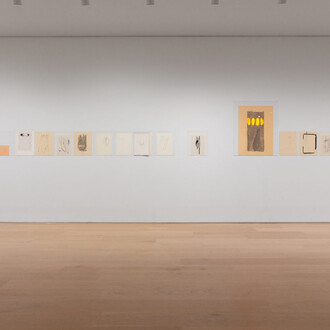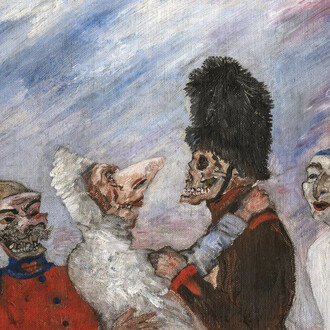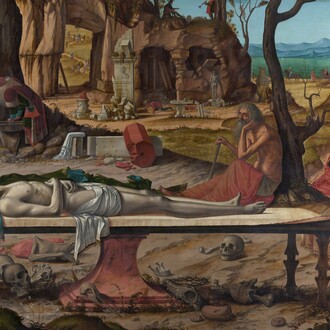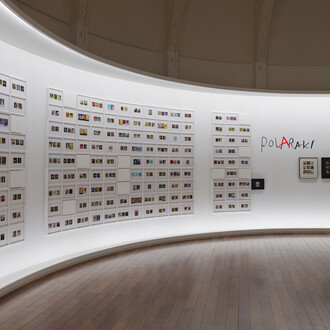Colourful prints from one of the most influential figures of the Pop Art movement, celebrating works from the years 1963 - 1997, the 15 pieces on show were heavily influenced by popular advertising and the comic book style.
American artist Roy Lichtenstein was born in New York City and grew up on Manhattan’s Upper West Side. In the 1960s, Lichtenstein became a leading figure of the new art movement, alongside Andy Warhol. Inspired by advertisements and comic strips, Lichtenstein’s bright, graphic images parodied popular culture. He died in New York City on September 29, 1997.
A groundbreaking American pop artist, Roy Fox Lichtenstein was born October 27, 1923, in Manhattan. He was the only child of Milton Lichtenstein, a prosperous real estate developer, and Beatrice Werner Lichtenstein. By all accounts, Lichtenstein was a quiet boy who kept to himself and showed a passion for science and comic books. At the age of 16, he became interested in art and began taking painting classes.
Following his graduation from The Franklin School, Lichtenstein attended The Ohio State University, but saw his time in Columbus, Ohio interrupted in 1943, when he was drafted and sent to Europe for World War II. Following the war, Lichtenstein returned to Ohio State to finish his undergraduate degree in art, which he followed with a master's, allowing him to later teach at the university.
For much of the 1950s, Lichtenstein, whose interest in Americana remained strong throughout his life, produced a range of work that blended his interest in American scenes (cowboys and Indians) with a touch that showed his reverence for European greats, such as Pablo Picasso. His body of work from this period also includes an interesting rendition of the famous painting "Washington Crossing the Delaware."
He started experimenting with pop art in the early 1960s, not long after he'd arrived at Rutgers University, where he'd been hired to teach. His work was as much a commentary on pop culture as it was on Abstract Expressionism. His paintings, which drew heavily on familiar characters found in comic books and advertising, seemed to be a direct contrast to the heavy-handed, search-for-meaning pieces coming out of so much of the rest of the art world.
His best-known image from this period is Whaam!, which Lichtenstein produced in 1963, using a comic book panel from a 1962 issue of DC Comics' All-American Men of War, as his inspiration. Later works included Mickey Mouse and Donald Duck.
"When I have used cartoon images, I've used them ironically," he once explained. "To raise the question: Why would anyone want to do this with modern painting?" But his work caught fire with the public, and subsequently, art dealers. By the mid-1960s he was nationally known, even if his work wasn't nationally respected. His place in the art world was complex, prompting Life magazine to do a story on Lichtenstein in 1964 that posed the question: "Is he the worst artist in America?"
The artist hardly seemed rattled by it. Unlike his some of his contemporaries, Lichtenstein wasn't dogged by self-doubt or personal demons. He was cool and even-tempered, personality traits that further set him apart from his contemporaries like Andy Warhol. "I don't have big anxieties," he said. "I wish I did. I'd be much more interesting."
By the late 1960s, Lichtenstein had stopped using comic book sources. His focus instead turned to creating paintings that seemed to either pay homage to or mimic the works of Picasso, Cezanne and others.
His art took other forms as well, such as the paintings of living rooms he made in the 1970s. A decade later he returned to sculpture, even producing a 25-foot-high called "Brushstrokes in Flight" that resides in the Port Columbus International Airport in Columbus, Ohio. He also produced a five-story-tall mural for the lobby of the Equitable Center in Manhattan.
Shy and never drawn to the spotlight, Lichtenstein continued to stay committed to his craft even toward the end of his life, often spending at least 10 hours a day in his studio. In 1995, he received the National Medal of Arts.
Lichtenstein married twice. He and his first wife, Isabel, whom he divorced in 1965, had two sons together. He married Dorothy Herzka in 1968. Lichtenstein died of complications from pneumonia on September 29, 1997, at the New York University Medical Center in Manhattan. He was living in Manhattan at the time of his death.
Olyvia Fine Art
17 Ryder Street, St.James's
London SW1Y 6PY United Kingdom
Ph. +44 (0)20 79252986
Opening hours
Monday - Friday
From 10am to 6pm














